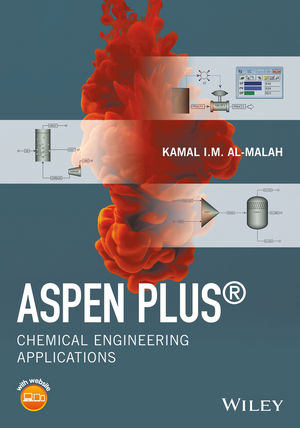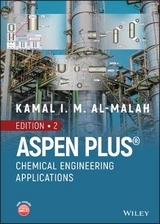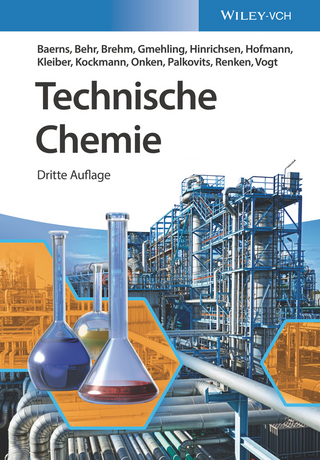
Aspen Plus® – Chemical Engineering Applications
John Wiley & Sons Inc (Verlag)
978-1-119-13123-6 (ISBN)
- Titel erscheint in neuer Auflage
- Artikel merken
Kamal Al-Malah, is professor of chemical engineering at Higher Colleges of Technology, United Arab Emirates and former chairman of the chemical engineering department at the University of Hail in Saudi Arabia. He holds B.S., M.S., and Ph.D. degrees in chemical/biochemical engineering. Dr. Al-Malah graduated from Oregon State University in 1993 and his area of specialty deals with mathematical modeling, optimization, simulation, and computer-aided design. Professor Al-Malah is Windows-based software developer and MATLAB(R) book author
Preface xvii The Book Theme xix About the Author xxi What Do You Get Out of This Book? xxiii Who Should Read This Book? xxv Notes for Instructors xxvii Acknowledgment xxix About the Companion Website xxxi 1 Introducing Aspen Plus 1 1.1 What Does Aspen Stand For?, 1 1.2 What is Aspen Plus Process Simulation Model?, 2 1.3 Launching Aspen Plus V8.8, 3 1.4 Beginning a Simulation, 4 1.5 Entering Components, 14 1.6 Specifying the Property Method, 15 1.7 Improvement of the Property Method Accuracy, 23 1.8 File Saving, 38 Exercise 1.1, 40 1.9 A Good Flowsheeting Practice, 40 1.10 Aspen Plus Built-In Help, 40 1.11 For More Information, 40 2 More on Aspen Plus Flowsheet Features (1) 49 2.1 Problem Description, 49 2.2 Entering and Naming Compounds, 49 2.3 Binary Interactions, 51 2.4 The Simulation Environment: Activation Dashboard, 53 2.5 Placing a Block and Material Stream from Model Palette, 53 2.6 Block and Stream Manipulation, 54 2.7 Data Input, Project Title, and Report Options, 56 2.8 Running the Simulation, 58 2.9 The Difference Among Recommended Property Methods, 61 2.10 NIST/TDE Experimental Data, 62 3 More on Aspen Plus Flowsheet Features (2) 71 3.1 Problem Description: Continuation to the Problem in Chapter 2, 71 3.2 The Clean Parameters Step, 71 3.3 Simulation Results Convergence, 74 3.4 Adding Stream Table, 76 3.5 Property Sets, 78 3.6 Adding Stream Conditions, 82 3.7 Printing from Aspen Plus, 83 3.8 Viewing the Input Summary, 84 3.9 Report Generation, 85 3.10 Stream Properties, 87 3.11 Adding a Flash Separation Unit, 88 3.12 The Required Input for Flash3 -Type Separator, 90 3.13 Running the Simulation and Checking the Results, 91 4 Flash Separation and Distillation Columns 99 4.1 Problem Description, 99 4.2 Adding a Second Mixer and Flash, 99 4.3 Design Specifications Study, 101 Exercise 4.1 (Design Spec), 105 4.4 Aspen Plus Distillation Column Options, 106 4.5 DSTWU Distillation Column, 107 4.6 Distl Distillation Column, 111 4.7 RadFrac Distillation Column, 113 5 Liquid Liquid Extraction Process 131 5.1 Problem Description, 131 5.2 The Proper Selection for Property Method for Extraction Processes, 131 5.3 Defining New Property Sets, 136 5.4 The Property Method Validation Versus Experimental Data Using Sensitivity Analysis, 136 5.5 A Multistage Extraction Column, 142 5.6 The Triangle Diagram, 146 References, 149 6 Reactors with Simple Reaction Kinetic Forms 155 6.1 Problem Description, 155 6.2 Defining Reaction Rate Constant to Aspen Plus(R) Environment, 155 6.3 Entering Components and Method of Property, 157 6.4 The Rigorous Plug-Flow Reactor (RPLUG), 159 6.5 Reactor and Reaction Specifications for RPLUG (PFR), 161 6.6 Running the Simulation (PFR Only), 167 Exercise 6.1, 167 6.7 Compressor (CMPRSSR) and RadFrac Rectifying Column (RECTIF), 168 6.8 Running the Simulation (PFR + CMPRSSR + RECTIF), 171 Exercise 6.2, 172 6.9 RadFrac Distillation Column (DSTL), 172 6.10 Running the Simulation (PFR + CMPRSSR + RECTIF + DSTL), 174 6.11 Reactor and Reaction Specifications for RCSTR, 175 6.12 Running the Simulation (PFR + CMPRSSR + RECTIF + DSTL + RCSTR), 179 Exercise 6.3, 180 6.13 Sensitivity Analysis: The Reactor s Optimum Operating Conditions, 181 References, 188 7 Reactors with Complex (Non-Conventional) Reaction Kinetic Forms 197 7.1 Problem Description, 197 7.2 Non-Conventional Kinetics: LHHW Type Reaction, 199 7.3 General Expressions for Specifying LHHW Type Reaction in Aspen Plus, 200 7.3.1 The Driving Force for the Non-Reversible (Irreversible) Case, 201 7.3.2 The Driving Force for the Reversible Case, 201 7.3.3 The Adsorption Expression , 202 7.4 The Property Method: SRK , 202 7.5 Rplug Flowsheet for Methanol Production, 203 7.6 Entering Input Parameters, 203 7.7 Defining Methanol Production Reactions as LHHW Type, 205 7.8 Sensitivity Analysis: Effect of Temperature and Pressure on Selectivity, 216 References, 219 8 Pressure Drop, Friction Factor, ANPSH, and Cavitation 229 8.1 Problem Description, 229 8.2 The Property Method: STEAMNBS , 229 8.3 A Water Pumping Flowsheet, 230 8.4 Entering Pipe, Pump, and Fittings Specifications, 231 8.5 Results: Frictional Pressure Drop, the Pump Work, Valve Choking, and ANPSH Versus RNPSH, 237 Exercise 8.1, 238 8.6 Model Analysis Tools: Sensitivity for the Onset of Cavitation or Valve Choking Condition, 242 References, 247 9 The Optimization Tool 251 9.1 Problem Description: Defining the Objective Function, 251 9.2 The Property Method: STEAMNBS , 252 9.3 A Flowsheet for Water Transport, 253 9.4 Entering Stream, Pump, and Pipe Specifications, 253 9.5 Model Analysis Tools: The Optimization Tool, 256 9.6 Model Analysis Tools: The Sensitivity Tool, 260 9.7 Last Comments, 263 References, 264 10 Heat Exchanger (H.E.) Design 269 10.1 Problem Description, 269 10.2 Types of Heat Exchanger Models in Aspen Plus, 270 10.3 The Simple Heat Exchanger Model ( Heater ), 272 10.4 The Rigorous Heat Exchanger Model ( HeatX ), 274 10.5 The Rigorous Exchanger Design and Rating (EDR) Procedure, 279 10.5.1 The EDR Exchanger Feasibility Panel, 279 10.5.2 The Rigorous Mode Within the HeatX Block, 294 10.6 General Footnotes on EDR Exchanger, 294 References, 297 11 Electrolytes 301 11.1 Problem Description: Water De-Souring, 301 11.2 What Is an Electrolyte?, 301 11.3 The Property Method for Electrolytes, 302 11.4 The Electrolyte Wizard, 302 11.5 Water De-Souring Process Flowsheet, 310 11.6 Entering the Specifications of Feed Streams and the Stripper, 311 References, 315 12 Polymerization Processes 325 12.1 The Theoretical Background, 325 12.1.1 Polymerization Reactions, 325 12.1.2 Catalyst Types, 326 12.1.3 Ethylene Process Types, 327 12.1.4 Reaction Kinetic Scheme, 327 12.1.5 Reaction Steps, 327 12.1.6 Catalyst States, 328 12.2 High-Density Polyethylene (HDPE) High-Temperature Solution Process, 329 12.2.1 Problem Definition, 330 12.2.2 Process Conditions, 330 12.3 Creating Aspen Plus Flowsheet for HDPE, 331 12.4 Improving Convergence, 338 12.5 Presenting the Property Distribution of Polymer, 339 References, 343 13 Characterization of Drug-Like Molecules Using Aspen Properties 361 13.1 Introduction, 361 13.2 Problem Description, 362 13.3 Creating Aspen Plus Pharmaceutical Template, 363 13.3.1 Entering the User-Defined Benzamide (BNZMD-UD) as Conventional, 363 13.3.2 Specifying Properties to Estimate, 364 13.4 Defining Molecular Structure of BNZMD-UD, 364 13.5 Entering Property Data, 370 13.6 Contrasting Aspen Plus Databank (BNZMD-DB) Versus BNZMD-UD, 373 References, 375 14 Solids Handling 379 14.1 Introduction, 379 14.2 Problem Description #1: The Crusher, 379 14.3 Creating Aspen Plus Flowsheet, 380 14.3.1 Entering Components Information, 380 14.3.2 Adding the Flowsheet Objects, 381 14.3.3 Defining the Particle Size Distribution (PSD), 382 14.3.4 Calculation of the Outlet PSD, 385 Exercise 14.1 (Determine Crusher Outlet PSD from Comminution Power), 386 Exercise 14.2 (Specifying Crusher Outlet PSD), 386 14.4 Problem Description #2: The Fluidized Bed for Alumina Dehydration, 387 14.5 Creating Aspen Plus Flowsheet, 387 14.5.1 Entering Components Information, 387 14.5.2 Adding the Flowsheet Objects, 388 14.5.3 Entering Input Data, 389 14.5.4 Results, 391 Exercise 14.3 (Reconverging the Solution for an Input Change), 392 References, 393 15 Aspen Plus(R) Dynamics 409 15.1 Introduction, 409 15.2 Problem Description, 410 15.3 Preparing Aspen Plus Simulation for Aspen Plus Dynamics (APD), 411 15.4 Conversion of Aspen Plus Steady-State into Dynamic Simulation, 416 15.4.1 Modes of Dynamic CSTR Heat Transfer, 417 15.4.2 Creating Pressure-Driven Dynamic Files for APD, 422 15.5 Opening a Dynamic File Using APD, 423 15.6 The Simulation Messages Window, 424 15.7 The Running Mode: Initialization, 425 15.8 Adding Temperature Control (TC) Unit, 426 15.9 Snapshots Management for Captured Successful Old Runs, 430 15.10 The Controller Faceplate, 431 15.11 Communication Time for Updating/Presenting Results, 434 15.12 The Closed-Loop Auto-Tune Variation (ATV) Test Versus Open-Loop Tune-Up Test, 434 15.13 The Open-Loop (Manual Mode) Tune-Up for Liquid Level Controller, 436 15.14 The Closed-Loop Dynamic Response for Liquid Level Load Disturbance, 443 15.15 The Closed-Loop Dynamic Response for Liquid Level Set-Point Disturbance, 448 15.16 Accounting for Dead/Lag Time in Process Dynamics, 450 15.17 The Closed-Loop (Auto Mode) ATV Test for Temperature Controller (TC), 451 15.18 The Closed-Loop Dynamic Response: TC Response to Temperature Load Disturbance, 459 15.19 Interactions Between LC and TC Control Unit, 462 15.20 The Stability of a Process Without Control, 464 15.21 The Cascade Control, 466 15.22 Monitoring of Variables as Functions of Time, 468 15.23 Final Notes on the Virtual (DRY) Process Control in APD, 472 References, 478 16 Safety and Energy Aspects of Chemical Processes 487 16.1 Introduction, 487 16.2 Problem Description, 487 16.3 The Safety Analysis Environment, 488 16.4 Adding a Pressure Safety Valve (PSV), 490 16.5 Adding a Rupture Disk (RD), 496 16.6 Presentation of Safety-Related Documents, 500 16.7 Preparation of Flowsheet for Energy Analysis Environment, 501 16.8 The Energy Analysis Activation, 506 16.9 The Energy Analysis Environment, 510 16.10 The Aspen Energy Analyzer, 512 17 Aspen Process Economic Analyzer (APEA) 523 17.1 Optimized Process Flowsheet for Acetic Anhydride Production, 523 17.2 Costing Options in Aspen Plus, 525 17.2.1 Aspen Process Economic Analyzer (APEA) Estimation Template, 525 17.2.2 Feed and Product Stream Prices, 527 17.2.3 Utility Association with a Flowsheet Block, 528 17.3 The First Route for Chemical Process Costing, 531 17.4 The Second Round for Chemical Process Costing, 532 17.4.1 Project Properties, 533 17.4.2 Loading Simulator Data, 535 17.4.3 Mapping and Sizing, 537 17.4.4 Project Evaluation, 544 17.4.5 Fixing Geometrical Design-Related Errors, 546 17.4.6 Executive Summary, 549 17.4.7 Capital Costs Report, 550 17.4.8 Investment Analysis, 551 18 Term Projects (TP) 565 18.1 TP #1: Production of Acetone via the Dehydration of Isopropanol, 565 18.2 TP #2: Production of Formaldehyde from Methanol (Sensitivity Analysis), 569 18.3 TP #3: Production of Dimethyl Ether (Process Economics and Control), 570 18.3.1 Economic Analysis, 570 18.3.2 Process Dynamics and Control, 572 18.4 TP #4: Production of Acetic Acid via Partial Oxidation of Ethylene Gas, 574 18.5 TP #5: Pyrolysis of Benzene, 575 18.6 TP #6: Reuse of Spent Solvents, 575 18.7 TP #7: Solids Handling: Production of Potassium Sulfate from Sodium Sulfate, 576 18.8 TP #8: Solids Handling: Production of CaCO3-Based Agglomerate as a General Additive, 577 18.9 TP #9: Solids Handling: Formulation of Di-Ammonium Phosphate and Potassium Nitrate Blend Fertilizer, 577 18.10 TP #10: Flowsheeting Options | Calculator : Gas De-Souring and Sweetening Process, 578 18.11 TP #11: Using More than One Property Method and Stream Class: Solid Catalyzed Direct Hydration of Propylene to Isopropyl Alcohol (IPA), 582 18.12 TP #12: Polymerization: Production of Polyvinyl Acetate (PVAC), 586 18.13 TP #13: Polymerization: Emulsion Copolymerization of Styrene and Butadiene to Produce SBR, 588 18.14 TP #14: Polymerization: Free Radical Polymerization of Methyl Methacrylate to Produce Poly(Methyl Methacrylate), 590 18.15 TP #15: LHHW Kinetics: Production of Cyclohexanone-Oxime (CYCHXOXM) via Cyclohexanone Ammoximation Using Clay-Based Titanium Silicalite (TS) Catalyst, 592 Index 595
| Erscheinungsdatum | 01.12.2016 |
|---|---|
| Verlagsort | New York |
| Sprache | englisch |
| Maße | 170 x 254 mm |
| Gewicht | 1394 g |
| Themenwelt | Naturwissenschaften ► Chemie ► Technische Chemie |
| Technik ► Maschinenbau | |
| ISBN-10 | 1-119-13123-5 / 1119131235 |
| ISBN-13 | 978-1-119-13123-6 / 9781119131236 |
| Zustand | Neuware |
| Informationen gemäß Produktsicherheitsverordnung (GPSR) | |
| Haben Sie eine Frage zum Produkt? |
aus dem Bereich



